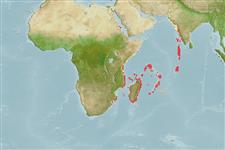>
Gobiiformes (Gobies) >
Gobiidae (Gobies) > Gobiinae
Etymology: Eviota: No etymology given, suggested by Christopher Scharpt: from Latin 'eu' for 'true' and 'iota' for anything very small, in combination 'truly very small' referring to it as being the smallest vertebrate at the time it has benn described by Jenkins (thus, making the suggestion by Scharpt plausible.; notata: Named for the large, dark marks on the head and nape (Latin word 'nota' meaning mark)..
Environment: milieu / climate zone / depth range / distribution range
Ecologia
marino associati a barriera corallina; distribuzione batimetrica 0 - 27 m (Ref. 92021). Tropical
Distribuzione
Stati | Aree FAO | Ecosystems | Presenze | Point map | Introduzioni | Faunafri
Western Indian Ocean: the Seychelles and Amirante Islands; Mauritius, Mascarene Islands, Cargados Carajos Shoals; and the Chagos Archipelago.
Size / Peso / Age
Maturity: Lm ? range ? - ? cm
Max length : 1.5 cm SL maschio/sesso non determinato; (Ref. 92021)
Short description
Chiavi di identificazione | Morfologia | Morfometria
Spine dorsali (totale) : 7; Raggi dorsali molli (totale) : 6 - 7; Spine anali: 1; Raggi anali molli: 6 - 7; Vertebre: 26. This species is distinguished from its congeners by the following characters: nape with a series of 3 prominent dark transverse marks, the first 2 of which are separated into enlarged spots dorsolaterally; dorsal to anal fin-ray formula 7/7; complete cephalic sensory pore system; pectoral-fin rays 10-14 always branched; first dorsal fin not elongate (Ref. 92021).
Life cycle and mating behavior
Maturities | Riproduzione | Spawnings | Egg(s) | Fecundities | Larve
Greenfield, D.W. and S.L. Jewett, 2012. Two new gobiid fishes of the genus Eviota from the Indian Ocean (Teleostei: Gobiidae). Zootaxa 3515:67-74. (Ref. 92021)
IUCN Red List Status (Ref. 130435)
Threat to humans
Harmless
Human uses
Strumenti
Special reports
Download XML
Fonti Internet
Estimates based on models
Preferred temperature (Ref.
123201): 25 - 28.9, mean 27.4 °C (based on 331 cells).
Phylogenetic diversity index (Ref.
82804): PD
50 = 0.5000 [Uniqueness, from 0.5 = low to 2.0 = high].
Bayesian length-weight: a=0.01023 (0.00477 - 0.02194), b=3.02 (2.84 - 3.20), in cm total length, based on LWR estimates for this (Sub)family-body shape (Ref.
93245).
Trophic level (Ref.
69278): 3.0 ±0.3 se; based on size and trophs of closest relatives
Fishing Vulnerability (Ref.
59153): Low vulnerability (10 of 100).
